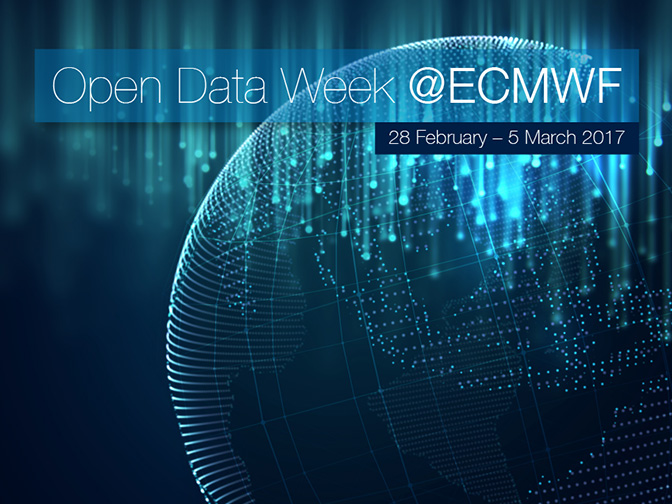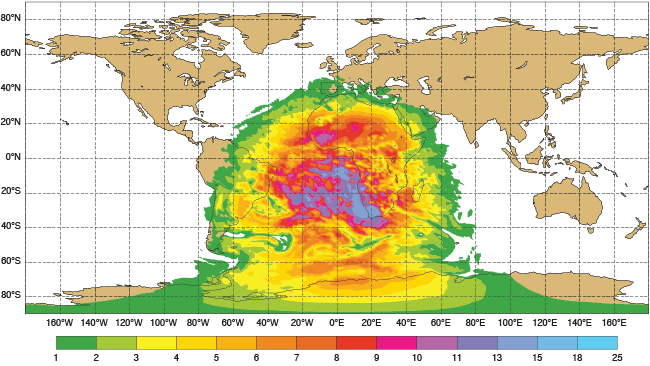

Open data will be in the spotlight during a week of events at ECMWF exploring the potential of freely available weather-related data.
Open Data Week @ECMWF, from 28 February to 5 March 2017, will focus on freely available data from ECMWF activities, including the EU-funded Copernicus Climate Change and Atmosphere Monitoring Services the Centre operates on behalf of the EU.
Scheduled to coincide with International Open Data Day on 4 March, key events include ECMWF’s regular Workshop on Meteorological Operational Systems (MOS) and a two-day hackathon.
With the largest meteorological archive in the world, hosting over 130 PB of data, ECMWF is a major provider of weather information.
As part of its role within the WMO and the meteorological community, the Centre has been providing an increasing amount of data to the public.
Some of the most widely used datasets include global climate reanalyses and atmospheric composition data, which are available to the public free of charge, and the TIGGE and S2S databases for research use.
Some real-time weather forecast data and charts are also available to the public, with users ranging from amateur enthusiasts to professional forecasters.
In 2014 ECMWF began operating the Copernicus Atmosphere Monitoring Service (CAMS) and Climate Change Service (C3S). These services are now making up-to-date environmental information freely available, with benefits for scientists, policy makers, education, businesses and the public at large.
Value of open data
Through the WMO’s World Weather Research Programme, ECMWF hosts and contributes forecasts to two major databases designed to help improve forecast skill and understanding in the medium and extended ranges, with an emphasis on severe weather.
The TIGGE archive comprises medium-range ensemble forecast data from ten global NWP centres, available to researchers just two days after production. S2S builds on this concept to provide sub-seasonal to seasonal forecasts and reforecasts from 11 centres.
ECMWF climate reanalyses – reconstructions of the global climate – and more recently C3S temperature maps charting monthly averages give vital insights for climate studies and policymakers.
Test data is now available from ECMWF’s newest global climate reanalysis, ERA5, which ECMWF is producing as part of C3S.
CAMS makes daily analyses and forecasts of global atmospheric composition available in real time. The catalogue includes 5-day forecasts of UV radiation that take into account the effect of ozone, clouds and aerosol particles.

A CAMS forecast from 5 December 2016 00 UTC for total-sky UV index at 12 UTC on the same day. The area of the highest predicted UV index values reflects the position of the Earth relative to the sun at that time of day and that time of year.
Such data is already contributing to numerous applications, for instance to raise public awareness of the health implications of high levels of UV or air pollution.
New approaches
To reach its full potential, data needs to be easily accessible as well as open. Providing increasingly large and complex datasets for scientists and industry to exploit poses challenges to traditional data centres.
New technologies and practices are needed to ensure efficient processing and fast visualisation. Possible strategies include cloud-based solutions and moving processing and visualisation to where data is stored.
As part of Open Data Week, ECMWF is dedicating its 2017 workshop on Meteorological Operational Systems (MOS) to the question of how to serve large volumes of data and how to enable easy access for users. This workshop, which takes place every two years, aims to review current and future developments in operational systems at ECMWF and national weather services. The 2017 edition will review current pull services, such as standardised web services (OGC, INSPIRE), and push services, such as product generation and dissemination.
Creative uses
In a first for ECMWF, the open data hackathon on 4 and 5 March invites developers, data journalists and data enthusiasts to look beyond weather and explore creative uses of open data.
The weekend of round-the-clock brainstorming and coding challenges participants to “get out, get creative and get geeky” to create new services and web applications for specific public and commercial needs.
Participants will have access to large volumes and a great variety of weather and climate data through standardised web services.
Open Data Week will start with a data policy workshop, giving invited delegates a forum to discuss the opportunities and consequences of introducing an open data policy for weather forecast data.
